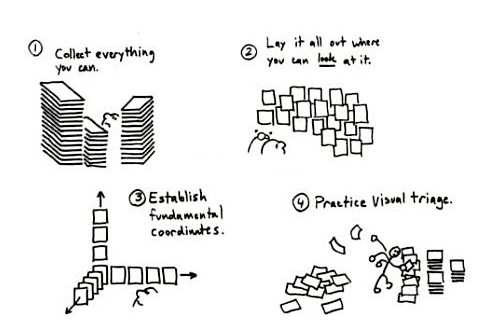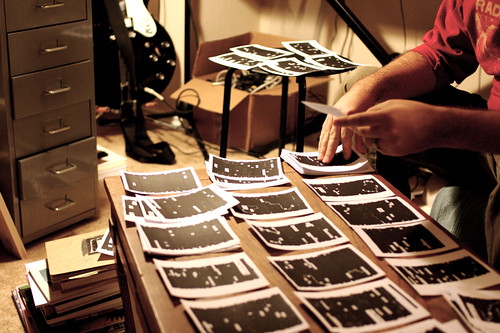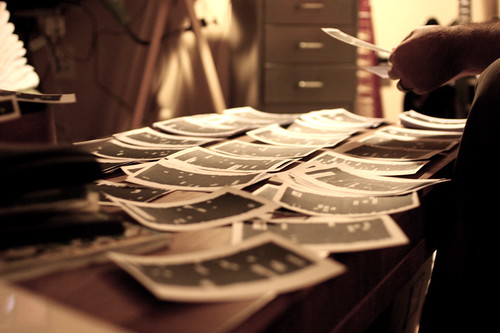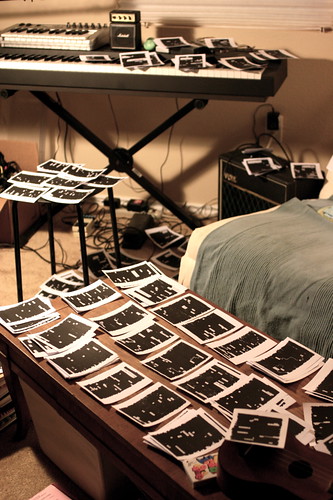Meg took these shots of me working on the book. At this stage, I have about 175 poems scanned and cleaned up. I’d like to have about 150. I was trying to organize them all on the computer in Adobe Bridge, but I wanted to be able to see them all, to touch them, to shuffle them, stack them, sort through them. I decided to print them all out on paper. Now I’m looking for themes and threads, stories and characters, trying to make this thing flow.
It’s a lot like making a mixtape, or sequencing an album. The way the songs butt up against each other can totally color their meanings. One could craft a hundred different albums from the same batch of songs.
The task now is looking. Trying to see a book in this stack of pages.
Dan Roam, in his book, The Back of the Napkin, says “there are four basic rules to apply every time we look at something new.”

1. Collect everything we can to look at—the more the better (at least at first).
2. Have a place where we can lay out everything and really look at it, side by side.
3. Always define a basic coordinate system to give us a clear orientation and position.
4. Find ways to cut ruthlessly from everything our eyes bring in—we need to practice visual triage.
Lay it all out where you can look at it. As Edward Tufte says, “Whenever possible, show comparisons adjacent in spaces, not stacked in time.”
Looking leads to seeing which leads to meaning.
David Hockney came to his theory on optics and painting by pinning a photocopied timeline of paintings down one wall of his studio:
He looked and was able to see a story.
Let’s hope it works for me.




Thought….
Taking from your (existing) poems, one, but then,adding, another, then another, then another…. to make and epic (existential) flow? Assuming this is what you refer to as color, or flow. As if you, possibly, never thought of this before. Thought.
Do you like William Carlos Williams? His variations? Just a thought.
I like everything of William Carlos Williams’ that I’ve read, but that isn’t all that much. “Red Wheelbarrow,” “This is Just To Say,” “The Use of Force,” etc.
I have to note that #3 is just as important as the others:
In this case, it’s giving labels to the piles as the sorting occurs:
Without labels and orientation, it’s easy to get lost in the mess:
Frank Warren does this when laying out a new PostSecret book:
See also: the practice of card-sorting.
How to Write a Memoir: an article by William Zinsser about being yourself, speaking freely, and thinking small | The American Scholar
http://j.mp/5QMr8N
“Go to your desk on Monday morning and write about some event that’s still vivid in your memory. What you write doesn’t have to be long—three pages, five pages—but it should have a beginning and an end. Put that episode in a folder and get on with your life. On Tuesday morning, do the same thing. Tuesday’s episode doesn’t have to be related to Monday’s episode. Take whatever memory comes calling; your subconscious mind, having been put to work, will start delivering your past.
Keep this up for two months, or three months, or six months. Don’t be impatient to start writing your “memoir,” the one you had in mind before you began. Then, one day, take all your entries out of their folder and spread them on the floor. (The floor is often a writer’s best friend.) Read them through and see what they tell you and what patterns emerge. They will tell you what your memoir is about and what it’s not about. They will tell you what’s primary and what’s secondary, what’s interesting and what’s not, what’s emotional, what’s important, what’s funny, what’s unusual, what’s worth pursing and expanding. You’ll begin to glimpse your story’s narrative shape and the road you want to take.”
I’m filing posts related to this process over at my Tumblr:
http://tumblr.austinkleon.com/tagged/lay_it_all_out_where_you_can_look_at_it